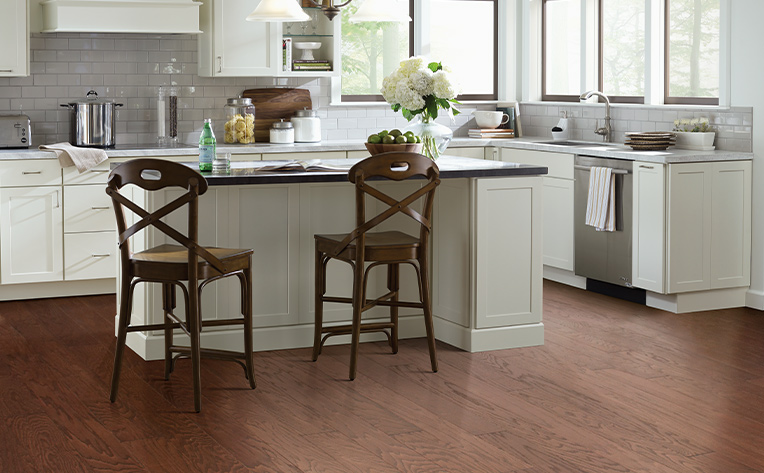Aug 21, 2025 | Flooring America

Choosing between light and dark hardwood floors is one of the first steps in creating a home that feels just right for you and your family. It might seem simple, but there's more to it than meets the eye! Maybe you've heard that dark wood creates a cozy vibe but can make a room feel smaller, or that light wood is bright and airy but harder to keep clean. As your local flooring store, we get it, picking the perfect flooring is a big decision, and we're here to help. Think of us as your friendly neighbor, ready to guide you through the pros and cons so you can feel confident and excited about your choice.
Choosing between dark and light wood floors? It all comes down to your style and how you want your home to feel. Both have their perks, so think about what fits your vision and favorite spaces.
Consider durability and what works for your family's lifestyle. If traditional hardwood isn't ideal, don't worry—there are great alternatives! Options like wood-look flooring, luxury vinyl, and laminate offer style and practicality.
As your local flooring store, we're here to help you create a warm, welcoming space. Look at the design trends you love and how they fit your home. Whether it's a renovation or a quick floor refresh, we'll guide you every step of the way. Let's find the perfect fit together!
Take a moment to evaluate the amount of natural light in the space where you're considering updating your flooring.
If your space has limited windows and tends to be a bit dark, choosing lighter hardwood floors can brighten things up and make it feel more welcoming. Lighter tones reflect light beautifully, creating an airy atmosphere that's especially helpful in places like basements or rooms with little natural light. On the flip side, if your space is already filled with abundant light from large windows or skylights, you might want to consider a bold dark wood flooring option. Darker hardwood brings a cozy sophistication, grounding your room's look and offering a lovely contrast against lighter walls or furniture. Finding the right balance between light and dark can truly enhance your home's design, making it feel both inviting and stylish. After all, we all want our spaces to feel like home!
Maintenance is a key factor to consider when choosing between light and dark hardwood floors. Both options bring unique benefits to your home, but they also come with their own cleaning and upkeep challenges. Here's a breakdown to help you make the best choice:
When deciding between light and dark hardwood flooring, think about:
Regardless of your choice, proper care is essential to extend the life of your hardwood floors. Check out our Hard Surface Floor Care and Warranty Guide for detailed cleaning tips and maintenance advice.
A clean, beautiful floor can transform your space, and with the right routine, your floors will stay stunning for years to come!
When considering light hardwood flooring, it's essential to weigh the potential downsides to ensure it's the right choice for your space.
Light hardwood floors bring a bright, airy feel to any room, but they can sometimes result in a washed-out appearance, especially when paired with light-colored walls. This effect is more noticeable in areas with lots of natural sunlight, where pale tones can make a room feel flat or overly uniform.
How to Fix It:
Lighter hardwood floors are more prone to fading over time, especially in spaces with direct sunlight. If this is a concern, consider fade-resistant finishes or window treatments to protect your flooring.
Expert Tip: Contact our flooring experts for advice on durable, fade-resistant options that maintain their light and fresh look over time.
Pairing light hardwood floors with light wood cabinets or walls can create a mismatched, washed-out aesthetic in kitchens or other spaces. Opt for complementary tones instead of matching shades. For example, contrast light flooring with darker cabinets or bold accent colors to create visual balance and a more cohesive design.
By addressing these potential drawbacks thoughtfully, light hardwood flooring can still deliver the clean and elegant look you're after without compromising on style or functionality.
Dark wood floors are rich and elegant, but they can sometimes make a space feel smaller or more enclosed. To counteract this effect, pair dark floors with light-colored walls. Shades like soft whites, creams, or pastels can create a balanced, open, and inviting atmosphere. This combination keeps your room feeling bright and cozy, perfect for any space.
One downside of dark wood floors is that scratches and scuffs tend to be more noticeable, especially in homes with pets or heavy foot traffic. If you're a pet owner, this can be a concern. Consider opting for pet-friendly flooring options that are scratch-resistant and durable to maintain your floor's sleek look without constant worry.
By understanding these challenges, you can make an informed choice when deciding between light and dark flooring!
.jpg?rnd=6683)
Still torn between light or dark hardwood floors? We understand, it's a big decision. That's why we offer our easy-to-use Room Visualizer tool. With just a few clicks, you can see how different wood shades look in your space, helping you make a confident choice you'll love for years to come. Want to take it a step further? You can order flooring samples online and test them out at home to make sure they're the perfect fit for your decor, which means no surprises, just peace of mind.
As your local flooring store, we're here to make the process as smooth as possible, from choosing the right hardwood to ensuring a seamless installation. We know your home is your haven, and we're proud to be your trusted neighbor in creating a space your family will cherish. For more tips, inspiration, and guidance, visit our flooring blog. Let's find the flooring that feels just right for you!